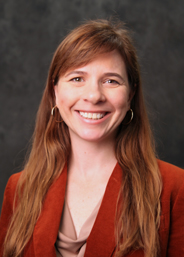- Home |
- Anna Linhoss
Anna Linhoss

Assistant Professor
Environmental Engineering, Water Resources
Agricultural and Biological Engineering
Office:241 Agricultural and Biological Engineering
alinhoss@abe.msstate.edu
P 662.325.3282
Personal Website
Education
Ph.D., Agricultural and Biological Engineering, University of Florida.
M.Sc., Agricultural and Biological Engineering, University of Georgia.
B.A., Anthropology, University of Colorado.
Experience Record
- Jan. 2013 – Present, Assistant Professor in Agricultural and Biological Engineering, Mississippi State University, Starkville, MS
- Oct. 2011 - Dec. 2012, Postdoctoral Associate in Agricultural and Biological Engineering, University of Florida, Gainesville, FL
- Jan. 2005 – May 2007, Environmental Scientist, Michael Baker Engineering, Ashville, NC
Specialty Areas
Hydrology and ecology are inherently linked to each other and work together to shape our water supply and water quality as well as the habitat and food supply for fish and wildlife. Feedbacks between hydrology and ecology go both ways. For example, hydrologic processes shape the physical characteristics of wetlands creating suitable habitat for specific plants and animals. On the other hand, ecologic processes, such as vegetation reinforcing streambanks, can determine hydrologic structure.
Research Interests
- The Okavango Delta is a large, remote, and ecologically significant wetland located in Botswana that receives a strong annual flood pulse. Although the hydrology in flood pulsed systems is often theorized to drive fish population dynamics, in the Okavango Delta there are no monitoring or modeling studies that quantify this complex ecological relationship. The objective of this project is to produce and analyze a mechanistic fish population model of the Okavango Delta that is driven by the annual flood pulse in order to corroborate the theory that Delta fish populations are driven by the flood signal.
link to literature - Anthropogenic activities have altered streams and rivers throughout Florida. Silvicultural practices, deadhead logging, road and bridge maintenance, de-snagging for navigation and flood control, and the clearing of riparian buffers for development have all impacted Florida’s streams and rivers through the loss of ecologically important woody material from stream banks and channels. Repercussions from these impacts include changes to sedimentation patterns and stream morphology, erosion of banks and bars, and the consequent loss of habitat structure. The loss of large woody material (LWM) presents far-reaching impacts on the hydrology, ecology, and water quality of southeastern coastal plain streams, however federal and state law regulating the removal and/or reintroduction of LWM remains murky. Current decision-making does not adequately account for LWM’s importance to Florida streams, and in many cases, the law appears to treat the removal of LWM more favorably than it does its reintroduction. We conclude that use of Best Management Practices associated with current statutory exemptions and categorical permits, as well as stakeholder education, offers the greatest promise of reducing the adverse impacts historic loss of LWM has had on coastal plain streams in Florida. Specific challenges include working with regionally appropriate techniques, balancing safety and accessibility with natural processes, and allowing for uncertainties.
- The development of watershed models with reduced quantified uncertainty under nonstationary conditions is a major challenge in the field of hydrology. This is especially problematic in data poor areas where values for model inputs are lacking or measured on temporally and/or spatially sparse scales. The objective of this project is to conduct a global sensitivity and uncertainty analysis (GSA/UA) of the Pitman semi-distributed hydrologic model for the data-poor Okavango Basin in southern Africa under both stationary and climate change scenarios. Results from this project are useful when determining the applicability of model predictions under stationary and nonstationary conditions and when focusing watershed monitoring efforts.
- Sea level rise is expected to impact natural and developed areas by shifting habitats and inundating infrastructure. It is important to identify both human and environmental vulnerabilities to sea level rise in order to plan for a sustainable future. We are involved in an interdisciplinary team investigating the impacts of sea level rise on land cover, habitat corridors, infrastructure, and economics. The results are shared with local stakeholders to promote a participatory approach to management within a scientifically informed framework.
Publications
Peer-reviewed Journal
- Linhoss, A.C., G. Kiker, M. Aiello-Lammens, M.L. Chu-Agor, M. Convertino, R. Muñoz-Carpena, R. Fischer, I. Linkov. 2013. Decision analysis for species preservation under sea-level rise. Ecological Modeling. In Press.
- Linhoss, A.C., L.G. Chambers, K Wozniak, T Ankersen 2013. A Multi-Disciplinary Review of Current Sea-Level Rise Research in Florida. University of Florida IFAS Electronic Data Information Source (EDIS) Publication.
- Linhoss, A.C., R. Muñoz‐Carpena, G. Kiker, D. Hughes, 2012. Uncertainty, sensitivity, and impacts for scenario modeling using the Pitman hydrologic model in the Okavango Basin. Submitted to Hydrological Sciences Journal. Posted ahead of print December 1, 2012. doi:10.1061/(ASCE)HE.1943-5584.0000755
- Linhoss, A.C., R. Muñoz‐Carpena, M. Allen, G. Kiker, K. Mosepele, 2012. A flood pulse driven fish population model for the Okavango Delta, Botswana: Evidence despite equifinality. Ecological Modeling 228 pp 27-38.
- Linhoss, A.C., A. Cameron, H. Hall, S. Blair, T. Ankersen. 2011, Large woody material: Science, policy, and best management practices for Florida streams. The Florida Scientist. 75(3) pp. 157–175.
- Kiker, G.A., R. Muñoz‐Carpena, P. Wolski, A. Cathey, A. Gaughan, J. Kim, 2008. Incorporating uncertainty into adaptive, transboundary water challenges: a conceptual design for the Okavango river basin. International Journal of Risk Assessment and Management 10(4) pp. 312−338.
- Vellidis, G., P. Barnes, D.D. Bosch, A. Cathey, 2006. Mathematical simulation tools for developing dissolved oxygen TMDLs. Transactions of the ASABE 49(4) pp. 1003−1022.
- Cathey, A., G. Vellidis, M.C. Smith, R. Lowrance, R. Burke, 2005. The calibration, validation, and sensitivity analysis of Georgia DoSag: An in‐stream dissolved oxygen model. (Total Maximum Daily Load) Proceedings of the Third Conference 5‐9 March 2005 (Atlanta, Georgia USA) 701P0105.
- Worley, J.W., M. Czarick, A. Cathey, 2000. Ammonia emissions from a commercial broiler house. Paper No. 024118 in Proceedings from 2002 ASAE Annual International Meeting/CIGR XVth World Congress, Chicago, Illinois.
